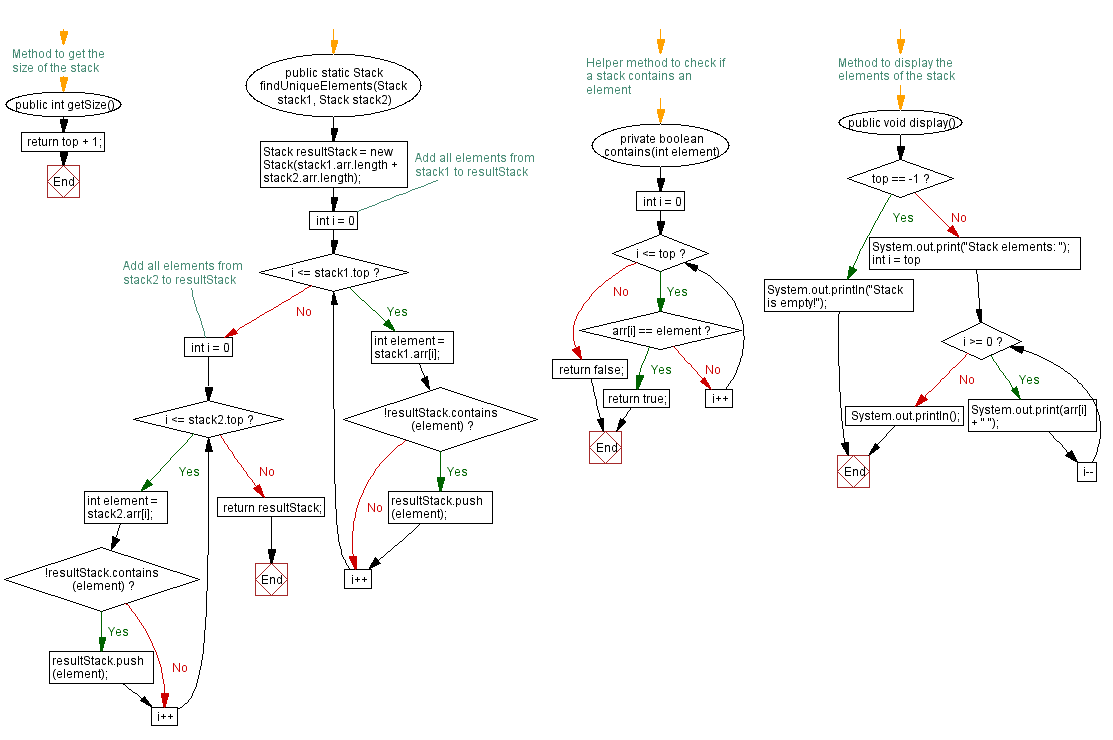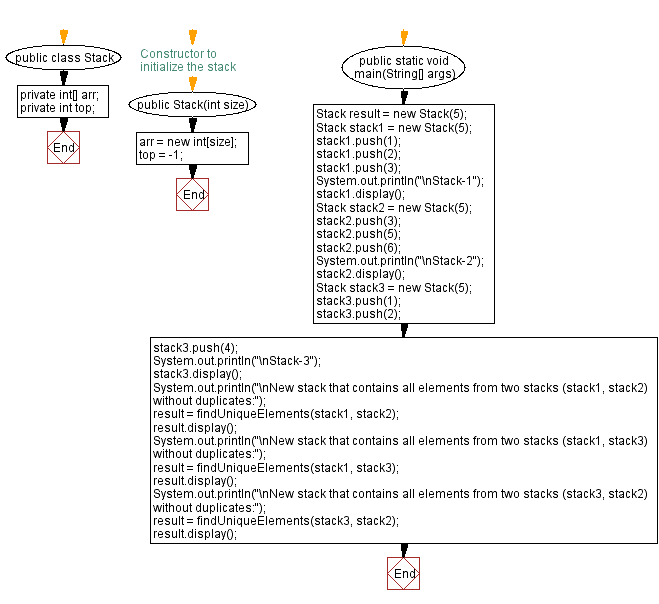Java: Elements from two stacks without duplicates
23. Create a new stack without duplicates from two stacks.
Write a Java program that implements a stack and creates a new stack that contains all elements from two stacks without duplicates.
Sample Solution:
Java Code:
import java.util.Scanner;
public class Stack {
private int[] arr;
private int top;
// Constructor to initialize the stack
public Stack(int size) {
arr = new int[size];
top = -1;
}
// Method to push an element onto the stack
public void push(int num) {
if (top == arr.length - 1) {
System.out.println("Stack is full");
} else {
top++;
arr[top] = num;
}
}
// Method to pop an element from the stack
public int pop() {
if (top == -1) {
System.out.println("Stack Underflow");
return -1;
} else {
int poppedElement = arr[top];
top--;
return poppedElement;
}
}
// Method to get the top element of the stack
public int peek() {
if (top == -1) {
System.out.println("Stack is empty");
return -1;
} else {
return arr[top];
}
}
// Method to check if the stack is empty
public boolean isEmpty() {
return top == -1;
}
// Method to get the size of the stack
public int getSize() {
return top + 1;
}
public static Stack findUniqueElements(Stack stack1, Stack stack2) {
Stack resultStack = new Stack(stack1.arr.length + stack2.arr.length);
// Add all elements from stack1 to resultStack
for (int i = 0; i <= stack1.top; i++) {
int element = stack1.arr[i];
if (!resultStack.contains(element)) {
resultStack.push(element);
}
}
// Add all elements from stack2 to resultStack
for (int i = 0; i <= stack2.top; i++) {
int element = stack2.arr[i];
if (!resultStack.contains(element)) {
resultStack.push(element);
}
}
return resultStack;
}
// Helper method to check if a stack contains an element
private boolean contains(int element) {
for (int i = 0; i <= top; i++) {
if (arr[i] == element) {
return true;
}
}
return false;
}
// Method to display the elements of the stack
public void display() {
if (top == -1) {
System.out.println("Stack is empty!");
} else {
System.out.print("Stack elements: ");
for (int i = top; i >= 0; i--) {
System.out.print(arr[i] + " ");
}
System.out.println();
}
}
public static void main(String[] args) {
Stack result = new Stack(5);
Stack stack1 = new Stack(5);
stack1.push(1);
stack1.push(2);
stack1.push(3);
System.out.println("\nStack-1");
stack1.display();
Stack stack2 = new Stack(5);
stack2.push(3);
stack2.push(5);
stack2.push(6);
System.out.println("\nStack-2");
stack2.display();
Stack stack3 = new Stack(5);
stack3.push(1);
stack3.push(2);
stack3.push(4);
System.out.println("\nStack-3");
stack3.display();
System.out.println("\nNew stack that contains all elements from two stacks (stack1, stack2) without duplicates:");
result = findUniqueElements(stack1, stack2);
result.display();
System.out.println("\nNew stack that contains all elements from two stacks (stack1, stack3) without duplicates:");
result = findUniqueElements(stack1, stack3);
result.display();
System.out.println("\nNew stack that contains all elements from two stacks (stack3, stack2) without duplicates:");
result = findUniqueElements(stack3, stack2);
result.display();
}
}
Sample Output:
Stack-1 Stack elements: 3 2 1 Stack-2 Stack elements: 6 5 3 Stack-3 Stack elements: 4 2 1 New stack that contains all elements from two stacks (stack1, stack2) without duplicates: Stack elements: 6 5 3 2 1 New stack that contains all elements from two stacks (stack1, stack3) without duplicates: Stack elements: 4 3 2 1 New stack that contains all elements from two stacks (stack3, stack2) without duplicates: Stack elements: 6 5 3 4 2 1
Flowchart:



For more Practice: Solve these Related Problems:
- Write a Java program to merge two stacks and then remove duplicates using a LinkedHashSet to preserve order.
- Write a Java program to combine two stacks into a new stack that contains only unique elements using streams.
- Write a Java program to merge two stacks iteratively and check for duplicates before pushing each element.
- Write a Java program to implement a method that merges two stacks and uses recursion to filter out duplicate elements.
Go to:
PREV : Find elements in the first stack but not in the second.
NEXT : Create a new stack from a portion of the original stack.
Live Demo:
Java Code Editor:
Improve this sample solution and post your code through Disqus
What is the difficulty level of this exercise?
Test your Programming skills with w3resource's quiz.
